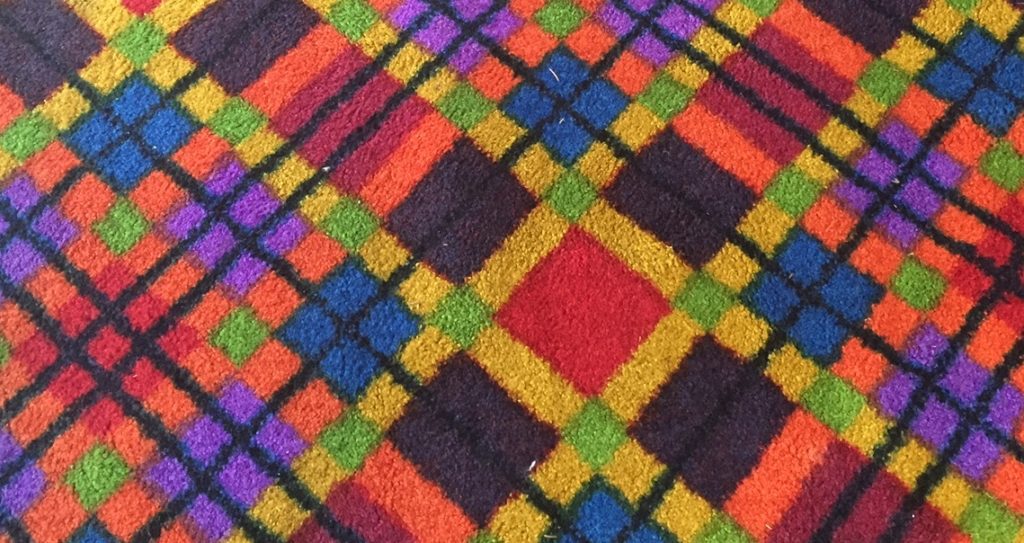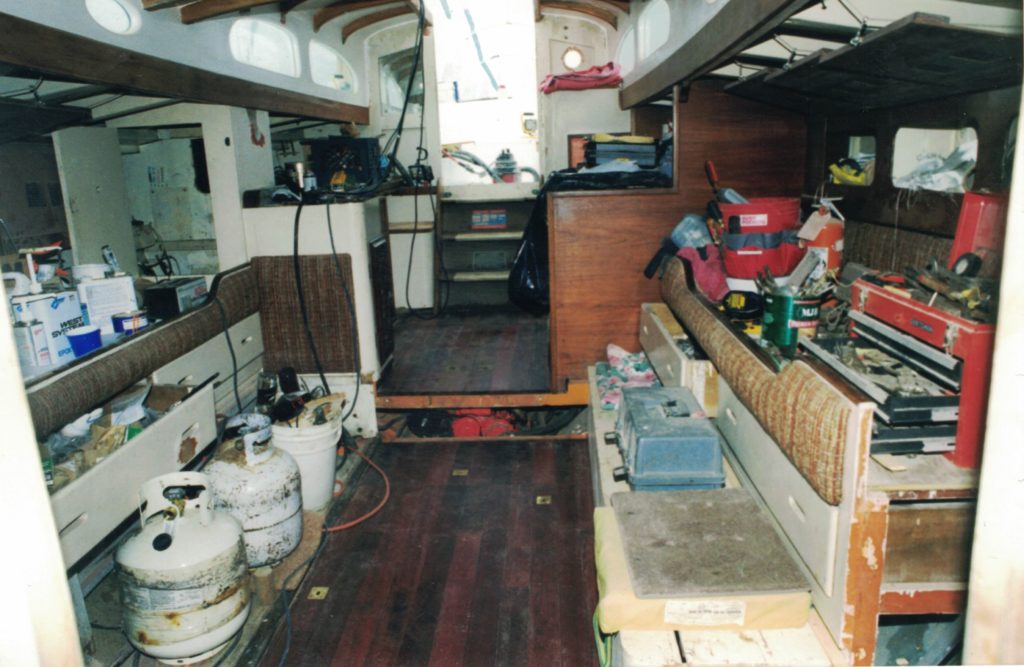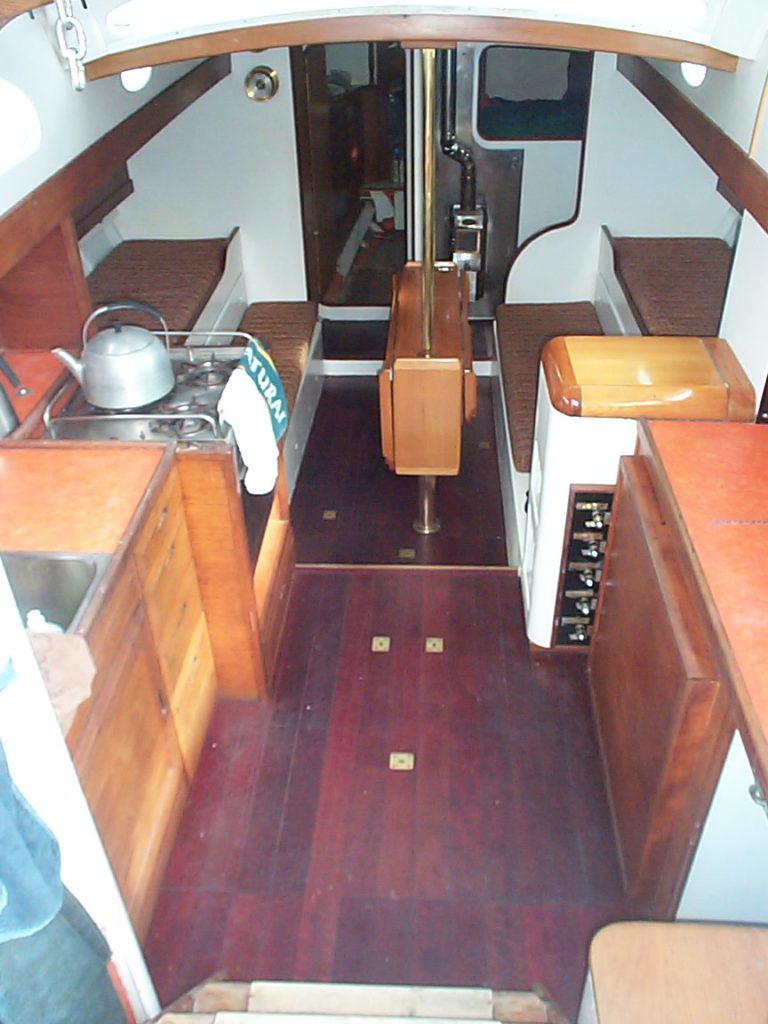The cabin sole is the floor of the cabin for the non-sailor persons who may wander in here. When we bought Leda, her galley floor was one piece of 3/4″ teak plywood. The engine is under the galley so every time you wanted to check the engine you had to struggle to get this piece of plywood up and find somewhere to put it. It had flattened out coffee cans nailed underneath for heat shields. The teak surface looked fine when it was down, but we needed something that gave us better access to the engine. I have no idea how long she had been sailing around like this. It was a horrid set up. The piece of plywood or the hatch as it might be considered was very difficult to get up without scaring the cabinets or one’s fingers. Then after it was up there was absolutely no place to stand or kneel over the engine which made it very hard to work on it. The result I think was that the engine got ignored a lot! I was already in there working on engine beds so developing some supporting beams for decking was part of the process. The new plan had four access hatches over the area so that they might be opened up in any combination.
Additionally there are three tanks in the bilge forward of the galley, two below the salon (one diesel and one water) and a third (water) under the floor in the head. I had taken these all out to clean and inspect the bilge. The original copper tanks were long gone. In their place were nicely made stainless steel tanks that we are still using, but the construction of the flooring over them was not impressive. I recall that the beams for the flooring were untreated fir with the ends held in tension between the ribs and the settee benches. I don’t remember was the flooring was. It had been covered with carpet.

The carpet was bright but as I mentioned earlier, I once found my tool box frozen to it. Not only did it get wet but it was impossible to dry out. It sort of stuns me to wonder how long it had been on board. Certainly it had been there when the Hylands had done their Pacific cruise. I realize I am not a fastidious person but I cannot go sailing without tracking some water into the cabin. Does anybody? It looks like its from the 70s more than 60s to me, but I can’t be sure. At some point there were teak cabinets made for the galley. I assumed this was all part of the big upgrade, mid-60s. As part of that remodel was a top loading icebox/refrigerator that had a 1964 refrigeration unit in it. The counter tops were covered with orange Formica at the same time. I’m guessing that the carpet went in when the orange Formica did. But it probably doesn’t matter, other than I am embarrassed to say that the orange Formica is till in the boat! I’ve threatened to paint it. Tearing it out won’t happen until there is another remodel. I guess it isn’t as irritating to me as I think it is as I have not changed it. It’s sort of ironic that the carpet in the photo above is an unused piece that was stored on the boat. I’ve kept it all these years and keep saying I am going to have the edge bound so that I can use it for a throw rug in the salon. A bit of color and memorabilia from days gone by.
Regardless, I was searching for wood to make the cabin sole from. It needed to be something that could take a lot of abuse. Additionally, I had been searching for wood to use as caps on my toe rail and coaming as I was not able to salvage what was there originally. I wanted to find a wood that was more or less fitting with a boat from New Zealand. I discovered Moxon Hardwoods in Portland, Oregon. I don’t remember now if they were an Australian company or New Zealand but they had offices in both countries. When I went to look at their inventory they also had purpleheart tongue-in-groove flooring. It was shockingly inexpensive and already milled and planed. So I figured out how much I needed to do the cabin sole for Leda. I bought something like 200 square feet for about 400 dollars. I bought merbau (also known also as kwila) for the cap rails at the same time.
Purple heart is great wood for taking a beating. It patinas dark but can be bleached back to purple. It’s a never ending battle due to my endlessly tracking water into the boat and we pretty much let ours go dark with an occasional refresh. The patina is coffee brown. It looks good but all these years later I am tempted to put in a floor that is painted light grey. It would be so much easier to see where you are going in the dark! It might still happen. But the good thing about natural wood is that you can scar it and it still looks good.

In the photo above the purple heart cabin sole can be seen. If you have plunged this far in, I will assume that other details here are worth noting. You can see the front of the Perkins diesel through the step up at the galley, so by now it was in place. To the left side of the step is the cabinet that originally held the phonograph. The one to the right had been removed to install a propane stove. The settee bunks can be seen on the far left and right in the foreground. These are original as are the drawers and benches below. However, I had to take out the starboard bench to get at the tanks below the sole. The steps leading down from the cockpit are original to the boat. Some of the orange Formica can be seen to the right of the steps where it forms the backslash for the sink. All that, and a mess to overlook.

The above is a slightly different view of the same mess. We can see some of the roof beams, now varnished with the paint refreshed between. I think the glass is back in the windows although it is a bit hard to tell. On the right in the foreground the end of the settee berth can be seen so the bulkhead has been torn out but a new one not installed as of yet. On the left propane tanks are sitting where the starboard bench once was. These are used to run a space heater when needed. In many of these photos, there are 8-D lead acid batteries sitting in that space. So presumably, I have now moved them under the cockpit where they now reside. I suspect this photo was taken late in 1996 or early 1997.

This is how that space ended up looking after I got it all put back together. This view obviously looking down the companionway from the cockpit. The cabinet for the phonograph has had its lid rebuilt and varnished up. In the immediate foreground on the right the original navigator’s seat is visible. It has a locker underneath but is otherwise nearly useless unless you are about ten years old you can’t fit in it. The hated orange Formica counters are clearly visible here. Somewhat amusing is the DB Natural bar towel hanging over the front of the stove. Ginny collected bar towels from all over New Zealand. It was my duty to drink beer so she could ask for the towels. It was hard work!
Next: Bulkheads
Previous: The Transom